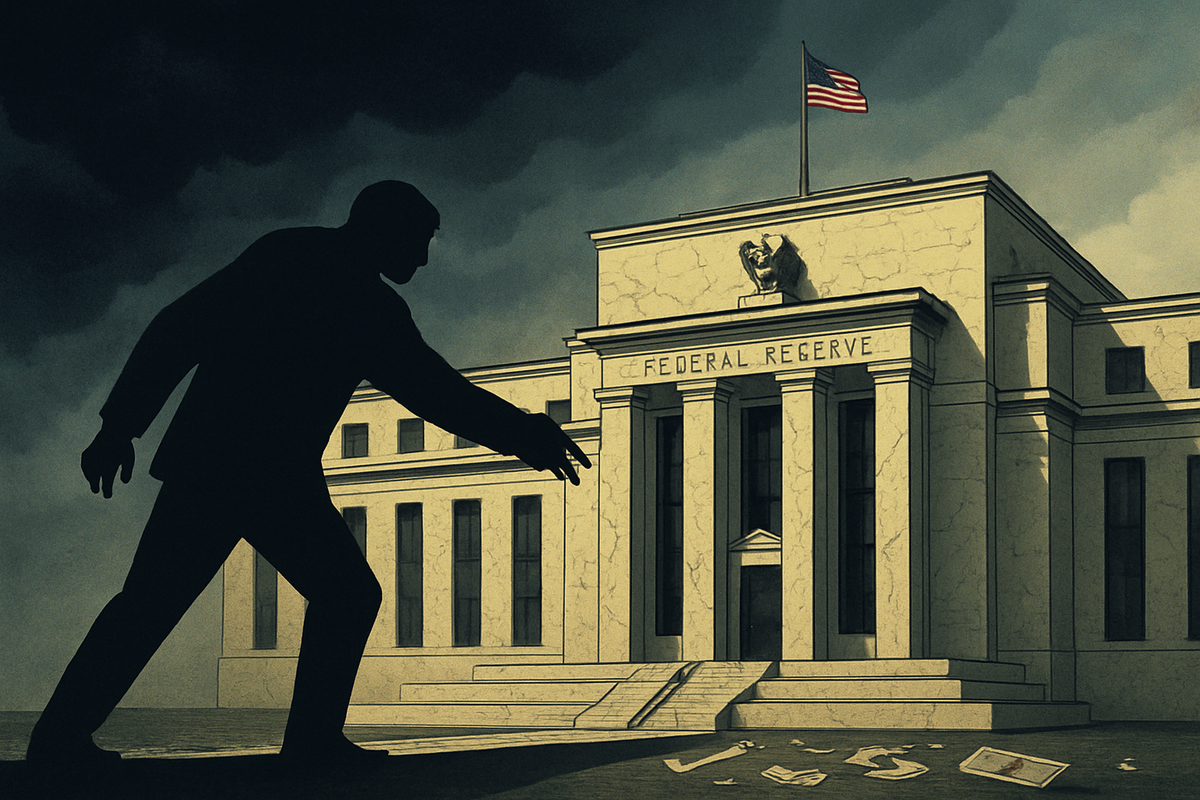
The Federal Reserve, the independent arbiter of U.S. monetary policy, finds itself increasingly at the epicenter of a political storm, facing intensified pressure from figures like former President Donald Trump to slash interest rates. This external influence, characterized by direct demands and sharp criticism, threatens to compromise the central bank's crucial independence, potentially steering monetary policy away from its dual mandate of stable prices and maximum employment towards short-term political expediency. As the calendar turns to November 19, 2025, the ongoing debate over the Fed's autonomy carries profound implications for financial markets, corporate strategies, and the broader economic stability of the nation.
The immediate implications of such political meddling are a heightened sense of uncertainty in financial markets and a palpable concern among economists regarding the potential for policy missteps. While lower rates might offer a temporary economic jolt, the long-term cost of a politicized Fed could be significant, ranging from persistent inflation to a loss of global confidence in the U.S. dollar. Investors and businesses are keenly watching how the Federal Reserve navigates these turbulent waters, understanding that its response will shape the economic landscape for years to come.
The Unprecedented Assault on Fed Independence
The history of political pressure on the Federal Reserve is long, but the intensity and public nature of recent criticisms, particularly from Donald Trump, are widely regarded as unprecedented in modern times. Throughout his presidency and continuing into 2025, Trump has launched a sustained campaign, often via social media platforms like Truth Social, demanding rate cuts and lambasting Fed Chair Jerome Powell. His rhetoric has included branding Powell as a "major loser," "grossly incompetent," and a "moron" for not aligning with his calls for aggressive rate reductions. For instance, in April 2025, he publicly asserted it was a "PERFECT time" for Powell to cut rates, ending his post with "CUT INTEREST RATES, JEROME, AND STOP PLAYING POLITICS!" He has also suggested rates should be no higher than 1.75%, significantly below the Fed's target range, and has openly contemplated and even "jokingly" threatened to fire Powell and other Fed officials.
These demands are typically couched in arguments that the Fed's higher interest rates are harming the U.S. economy, stifling the housing market, and increasing the national debt. Trump frequently points to other central banks, particularly in Europe, that have implemented rate cuts, implying the U.S. Federal Reserve is lagging. The context for these comments often stems from a desire to maintain a booming stock market and sustained economic growth, which he frequently attributes to his policies. His pressure intensified as his trade policies created economic uncertainty, leading him to view lower interest rates as a necessary countermeasure.
Initial market reactions to such direct political interference have often been negative. In April 2025, following Trump's renewed criticisms, U.S. stock markets (S&P 500, Dow Jones Industrial Average, Nasdaq Composite) all experienced sharp declines of over 2%. The U.S. dollar also slid to multi-year lows, while gold, a traditional safe-haven asset, reached record highs, signaling investor discomfort with the instability generated by perceived threats to monetary policy independence. Economists and financial analysts have consistently voiced strong concerns, with a survey in August 2025 indicating that over 77% were worried about White House interference with the Fed, warning of increased risks of higher inflation and politically-influenced monetary policy mistakes.
Corporate Fortunes in a Rate-Sensitive Environment
The prospect of politically induced interest rate cuts creates a stark divide in potential outcomes for public companies, with some sectors poised to gain significantly while others may face headwinds. Understanding these dynamics is crucial for investors navigating a potentially volatile market.
Companies that typically benefit from lower interest rates are those with high capital expenditures, significant debt, or those that rely on consumer financing for their products. The real estate and homebuilding sector stands to be a major winner. Lower mortgage rates make homes more affordable, boosting demand and sales for homebuilders like PulteGroup (NYSE: PHM), D.R. Horton (NYSE: DHI), and Lennar (NYSE: LEN). Suppliers to this industry, such as Builders FirstSource (NYSE: BLDR) and Mohawk Industries (NYSE: MHK), would also see increased demand. Similarly, technology and growth stocks, which often rely on borrowing to finance innovation and derive much of their valuation from future earnings, would see their borrowing costs decrease and their valuations potentially increase due to a lower discount rate. Companies like Shopify (TSX: SHOP), Thryv Holdings, Inc. (NASDAQ: THRY), and Block (NYSE: SQ) could see a boost. The consumer discretionary sector, including companies like Royal Caribbean Cruises Ltd. (NYSE: RCL) and General Motors (NYSE: GM), would also benefit from increased disposable income and cheaper financing for big-ticket purchases. Capital-intensive utilities like Duke Energy (NYSE: DUK) and Exelon (NASDAQ: EXC) would see reduced borrowing costs for their extensive infrastructure projects.
Conversely, certain sectors, particularly within financials, could experience negative impacts. Banks, which profit from the spread between interest earned on loans and interest paid on deposits (net interest margin or NIM), often see these margins compress in a low-rate environment. While lower rates might stimulate loan demand, the overall profitability of major banks like JPMorgan Chase (NYSE: JPM), Bank of America (NYSE: BAC), and Wells Fargo (NYSE: WFC) could be challenged if they cannot reduce deposit rates proportionally. Consumer staples companies, such as Procter & Gamble (NYSE: PG) or Coca-Cola (NYSE: KO), while defensive, might underperform as investors rotate out of stable, income-generating assets into higher-growth sectors seeking better returns in a low-rate environment. Additionally, while utilities benefit from cheaper debt, if rates fall too low, their dividend yields might become less attractive compared to other investments, potentially leading to overvaluation risks after an initial rally.
The Broader Ramifications of a Politicized Fed
The political pressure on the Federal Reserve extends far beyond immediate market fluctuations, carrying profound wider significance for global finance, regulatory frameworks, and the very credibility of central banking. This trend fits into a broader global discussion about the role and independence of central banks, especially in a world grappling with persistent inflation, geopolitical instability, and calls to expand their mandates beyond traditional price stability.
One of the most critical ripple effects is on global capital flows and emerging markets. Lower U.S. interest rates, particularly if perceived as politically driven, can trigger capital outflows from the U.S. to higher-yielding emerging market economies. While this might offer a short-term boost to those markets, it also introduces financial risks, especially for nations with fragile economic fundamentals. Furthermore, Fed rate cuts often prompt similar actions by other major central banks, fostering a trend of global monetary easing that can impact currency valuations and international trade. A weaker U.S. dollar, a likely outcome of lower rates, could make U.S. exports more competitive but also affect the trade balances of other nations.
The most significant regulatory and policy implication is the erosion of central bank independence. This independence is a cornerstone of stable economic policymaking, designed to shield monetary decisions from short-term political cycles. When central banks succumb to political pressure, it can lead to inflationary policies and economic instability, as seen in countries with less independent central banks that experience higher inflation and greater volatility. The credibility of the Fed, once compromised, is incredibly difficult to restore and can lead to "fiscal dominance," where the central bank is forced to prioritize financing government spending over controlling inflation, potentially leading to hyperinflation. Efforts to remove Fed officials who do not align with administration priorities further test the structural safeguards designed to insulate the Fed from political control.
Historically, the Federal Reserve has faced political pressure since its inception. During World War I and II, it was pressured to finance war efforts. President Franklin D. Roosevelt influenced monetary policy during the Great Depression. However, landmark moments like the 1951 Fed-Treasury Accord under President Harry Truman and Fed Chair William McChesney Martin's defiance of President Lyndon B. Johnson in 1965 helped cement the Fed's independence. A cautionary tale is President Richard Nixon's influence over Fed Chair Arthur Burns in the early 1970s, which led to expansionary policies before the 1972 election and contributed significantly to the rampant inflation of that decade. International comparisons, such as the experiences of Argentina, Turkey, and Zimbabwe, starkly illustrate the dangers of politicized central banks, which often result in spiraling inflation, loss of currency credibility, and economic volatility.
Navigating the Future: Scenarios and Strategic Pivots
Looking ahead, the Federal Reserve's path will be critically shaped by its ability to withstand political pressure while responding to evolving economic data. The short-term possibilities suggest that if economic weakness persists, the Fed might consider rate cuts, but it will likely do so cautiously, balancing calls for stimulus against persistent inflation concerns. However, intensified political demands, especially during an election cycle, could force the Fed to act more aggressively than economic fundamentals alone would warrant, providing a temporary economic boost but risking higher inflation.
In the long term, the sustained political pressure poses an existential threat to the Fed's independence. Should this independence erode, the nation could face higher and more persistent inflation, de-anchored inflation expectations, and even "fiscal dominance," where monetary policy is dictated by government borrowing needs. This could ultimately lead to reduced economic growth, increased instability, and a weakening of the U.S. dollar's global standing. More extreme scenarios even contemplate legislative changes to bring the Fed under direct Treasury control, effectively merging monetary and fiscal policy.
For businesses, strategic pivots will be essential. Lower interest rates could offer opportunities for cheaper capital investment, encouraging expansion in capital-intensive industries and facilitating debt refinancing. Consumer discretionary spending could increase, boosting sales. Real estate and asset values might rise, benefiting businesses holding such assets. However, challenges include the potential for rising input costs if politically driven rate cuts lead to higher inflation, eroding profit margins. Banks could see compressed net interest margins, and consumer purchasing power could diminish if inflation outpaces wage growth. Businesses will need to build resilience against potential supply chain disruptions and input cost volatility.
Market participants face both opportunities and challenges. Opportunities include potential equity market rallies, particularly for growth stocks, as lower rates reduce the discount rate for future earnings. Gold and other alternative assets could become more attractive as hedges against inflation and instability. Specific sectors like housing, construction, and durable goods could see a boost. However, the primary challenge is the risk of significant and persistent inflation, leading to de-anchored inflation expectations and bond market volatility. A weaker U.S. dollar could impact global capital flows, and the combination of aggressive rate cuts and increased government debt could lead to systemic financial instability. Investors must monitor these dynamics closely, as the Fed's ability to maintain its independence will be a critical determinant of market stability and economic trajectory.
A Crossroads for Monetary Policy: The Lasting Impact
The current political pressure on the Federal Reserve to lower interest rates marks a critical juncture for U.S. monetary policy. The key takeaway is that while short-term economic stimulus might be a perceived benefit of politically influenced rate cuts, the long-term costs of eroding central bank independence are substantial and potentially catastrophic. Historical precedents consistently demonstrate that a central bank subservient to political demands often leads to unchecked inflation, economic instability, and a loss of national and international credibility.
Moving forward, the market will be keenly assessing the Federal Reserve's resolve. Its ability to communicate its decisions clearly, based on economic data rather than political expediency, will be paramount in maintaining confidence. A successful navigation of these pressures would reinforce the Fed's independence and its commitment to its dual mandate, fostering long-term stability. Conversely, any perceived capitulation could trigger a period of heightened market volatility, inflationary pressures, and a re-evaluation of the U.S. dollar's role in the global financial system.
Investors should watch for several key indicators in the coming months: the Fed's official statements and minutes for any shifts in language or policy direction, inflation data and labor market reports for signs of economic health, and most importantly, the tone and frequency of political rhetoric directed at the central bank. The ultimate significance of this period will be whether the Federal Reserve can uphold its independence, ensuring that monetary policy decisions continue to be guided by sound economic principles rather than the fleeting demands of political cycles. The lasting impact will reverberate through every corner of the financial world, shaping investment strategies, corporate planning, and the economic well-being of the nation.
This content is intended for informational purposes only and is not financial advice






